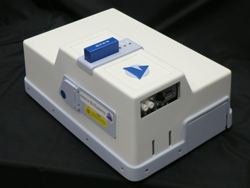
A prototype of the AIR platform, which monitors
strains of the flu virus in order to develop effective
vaccines. [Permission granted by Benjamin Miller]
To stop a flu epidemic before it starts, you’ve got to know your enemy. But for epidemiologists and vaccine developers involved in the annual fight against the flu, it’s not enough to identify the mere presence of a flu virus. You’ve got to know exactly which virus you’re dealing with and how widely it has spread.
Figuring that out can be costly and difficult for scientists racing to contain a highly contagious disease, but an innovative, newly-patented test that needs only a drop of blood and a silicon chip offers hope for speeding up the process. And its inventor thinks his device, which may be on the market as early as next year, could be useful for detecting other diseases, too.
“What really excites me is having this tool that people come up to me with exciting applications that I haven’t thought of — that really is neat to me,” says Benjamin Miller, a dermatologist at the University of Rochester in New York.